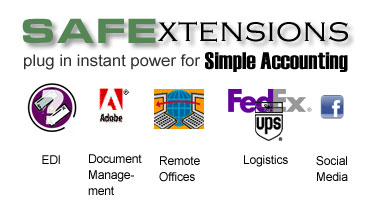In this section of the program, you tell Simple Accounting about your company. Begin by entering your Master Password.
Fields
| DEFAULT BANK ACCOUNT | This field holds the bank account to be used by A/R and A/P for all transactions (unless you override when entering a specific transaction. |
| PETTY CASH ACCOUNT | This field holds the bank account used as your /set-up-general-ledger-options. Although not really a bank account, the petty cash account is treated as such in Simple Accounting to help you manage small purchases. An entry is made into the check register for each purchase made with petty cash. |
| POST TO G/L | This checkbox determines whether or not transactions will post to the general ledger and update the various financial reports. When you first install SAFE EE this field is turned off in order to properly set up the system. When you run your first Period Update this field is automatically checked to enable G/L posting. If you decide to not use the G/L functions you can turn this field off again at any time thereafter.
We Repeat! Leave this field unchecked while you are setting up SAFE EE. It will automatically be activated after you enter your starting G/L balances. Danger! Accidentally turning this field off after setting up Simple Accounting will throw your books out of balance. Our advice: Don’t touch! |
Key G/L Accounts
The following are key G/L accounts which Simple Accounting needs to know about before you begin processing:
| CURRENT EARNINGS | The account to which all revenue and expense accounts clear. This account holds the net/profit loss of the company at any given time within the current accounting year.
Manual entries should be never be made to this account! |
| RETAINED EARNINGS | Holds the accrued earnings of your organization. This account is automatically updated with the cumulative CURRENT EARNINGS for the year when you perform a Year End Close.
Manual entries should be generally not be made to this account except when entering your beginning balances! |
| CASH RECEIPTS | The default G/L account for all new bank accounts.
This is not the account to which all cash will post, only the default. In fact, every bank account should probably have its own separate G/L account. |
| ACCOUNTS RECEIVABLE | The account to which the total of all customer balances will be stored. |
| ACCOUNTS PAYABLE | The account to which balances due to your vendors will be stored. |
| INVENTORY | The default asset account to which changes in the total value of your inventory will be posted. This is also the default value when entering a new product type.
This is not the account to which all inventory will post, only the default. In fact, products post to inventory based on their Product Type. This allows you to track different items in separate asset accounts. |
| COST OF GOODS SOLD | The default account for CoGS when entering a new Product Type.
It is the Product Type that actually sets the sales revenue account for each item sold. |
| PURCHASE DISCOUNTS | The account to post credit you are allowed from your vendors for early payment on their invoices. Discounts are entered when you tag vendor invoices for payment. |
| SALES DISCOUNTS | The account to post credit you allow customer for early payment on their invoices. Discounts are entered when you receive payment from a customer. |
| SALES RETURNS | The expense account to be debited whenever product is returned. |
| PRIMARY SALES REVENUE | The default G/L account for sales revenue when entering new Product Type.
It is the Product Type that actually sets the sales revenue account for each item sold. This is merely the default for each Product Type. |
| FREIGHT REVENUE | The revenue you derive from freight charged to customers. |
| FREIGHT EXPENSE | The shipping expense charged to you for items shipped from your vendors. You can override this account for each Ship To on each Sales Order. |
| ARTWORK REVENUE | The revenue you derive from artwork charged to customers This expense is posted when a sales orders is invoiced. |
| ARTWORK EXPENSE | The default G/L account for cost of artwork on each item sold. You can override this account for each line item on each Sales Order. This is account is posted to when a sales order is invoiced. |
| FINANCE CHARGES | The revenue you derive from customers who pay late on their balances. This is automatically posted to when you run Apply Customer Finance Charges. |
Financial Calendar
| NUMBER OF PERIODS | The number of accounting periods per accounting year. The default is thirteen. This field cannot be changed once the company has been initialized. |
| CURRENT YEAR | The current accounting year. This field is automatically incremented after a Year-end Close. |
| CURRENT PERIOD | The current accounting period (1-99). You may have up to ninety-nine periods in any one accounting year and the accounting year may start whenever you choose. However, it is up to you to decide when to close out accounting periods. This field is automatically incremented after a Period Update. This field cannot be changed once the company has been initialized.
It is very important that you be aware of the current accounting period because all transactions are posted to this period and current year. |
| SAVE HISTORY | This sets the number of years that Simple Accounting will keep transactions on line. The default is two years. The maximum is 9999.
Bear in mind, setting a large Save History number can be advantageous; however, it does require two important considerations: 1. The more on-line storage you retain the longer the system will take to perform certain tasks such as lengthy reports. After all, the more records the system tracks, the longer it takes to process information. The loss in speed is usually small and can be minimized by following our suggestions in the Computer Tips topic. 2. Also, you should be certain that, as time goes by, you will have enough available hard disk space to support this on line history. See the section on Estimating Storage Requirements to determine this. |
Non-Editing Fields
| LAST PERIOD UPDATE | The date of the last Period Update. This means all transactions posted through the indicated date. This field is updated automatically during the Period Update and is non-editing. |
| DEFAULT G/L TRANSACTION PERIOD TO | This determines to which period Simple Accounting will automatically post G/L transactions as needed (for example, when printing A/R invoices or printing A/P checks.) |
Calendar Month
When transactions are automatically created, they will be posted to the period of the month of the transaction. For example, if the transaction is a customer invoice and the invoice date is 07/15/98 then the G/L period the transaction will be posted to is 7. The transaction is always posted to the period based on the transaction date, regardless of the current system G/L period.
(Default Value)
System G/L Period
G/L transactions (except for manual entries into the Audit Trail are always posted to the Current System G/L Period, regardless of the calendar date. So if the current date is 07/02/98 but the current G/L period is still 6, then G/L postings will automatically be posted to period six.
| USE PRODUCT TYPE FREIGHT REVENUE ACCOUNT? | Check this box to enable posting freight to an alternative freight revenue account as set for each Product Type. Note that if a Product Type has no Freight Revenue account set, then the Master Freight Revenue account is used. |
| OUT OF BALANCE FILTER: | Use this field to create a Simple Accounting filter expression which excludes certain transactions from checking for out of balance condition. You would typically use enter an expression here if you had begun posting to the G/L at some point after using sales or A/P modules. This would prevent those early transactions from being checked for posting to the G/L. |
| UNPOSTED FILTER: | Entering a valid Simple Accounting query expression will automatically exclude matching transactions from being checked for an unposted status. This is helpful if you began using various modules at different times and wish to prevent earlier transactions from being checked for correct G/L posting. You can enter a separate filter to each of these types of transactions
Sales Orders/Invoices A/P Invoices Check Register |
| OFFER TO RE-POST TO ORIGINAL PERIOD? | When a Source Transaction is edited, thus causing the G/L Posting to be rebuilt, you will be given the choice to repost any changes to the current G/L Period or to the original period in which it was entered (so long asthat Period is not Locked.) |
| REVERSE VOIDS? | Check this box if you wish Simple Accounting to automatically post a reversing entry to the G/L Audit Trail when a Source Transactions is voided. Leave this blank if you wish a voided Source Transaction to be removed from the G/L Audit Trail. |



